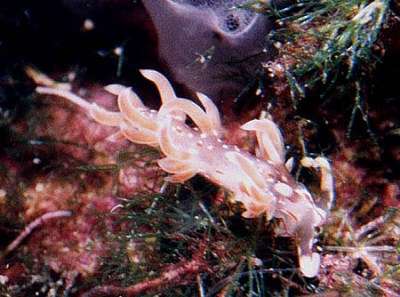
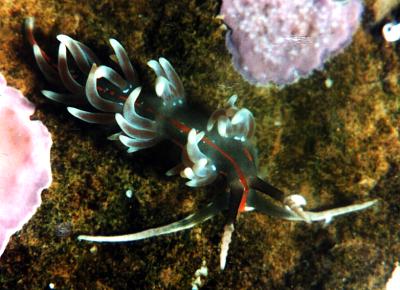
Facelina rubrovittata
(A. Costa, 1866)
Order: NUDIBRANCHIA
Suborder: AEOLIDINA
Family: Glaucidae
DISTRIBUTION
Western Mediterranean & Atlantic coast of Spain.
PHOTO
UPPER: Cala Llevadó (Costa Brava, Spain) on a rocky bottom at 10 meters, June 1998. PHOTO: Miquel Pontes.
LOWER: Bay of Algeciras (Strait of Gibraltar, Southern Spain), Size: 20 mm, Depth: 18 m., April 2000. PHOTO: Alma Sánchez
Maximum length 14mm. Rhinophores smooth in smaller animals but lamellated in larger ones. In contrast to the similarly coloured Facelina fusca, in F. rubrovittata the tips of the rhinophores, oral tentacles and sometimes the cerata are covered with opaque white. Basal region of the rhinophores is brown. There are usually 5 broken orange lines down the body. There is a median line from the front of the head running down the back between the rhinophores and another line on each side below the rhinophores and the cerata. The other two lines often consist of orange dots on each side between the ceratal clusters. This species feeds on the hydroid Eudendrium.
Reference:
• Schmekel, L. & Portmann, A. (1982) Opisthobranchia des Mittelmeeres. Springer-Verlag: Berlin. 410pp.
Rudman, W.B., 2000 (January 23) Facelina rubrovittata (A. Costa, 1866). [In] Sea Slug Forum. Australian Museum, Sydney. Available from http://www.seaslugforum.net/find/facerubr
Related messages
Re: Facelina rubrovittata feeding
April 7, 2009
From: Dominique Horst
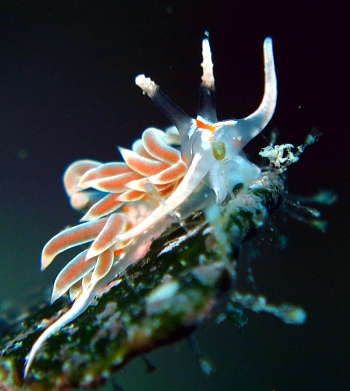
Concerning message #21318:
Hi Bill,
This is another episode of Facelina rubrovittata feeding. It seems that it's feeding on the same hydroids as Caloria elegans.
Locality: Antibes, 12 m, France, Mediterranean sea, 22 March 2009. Length: 6 mm. Photographer: Dominique Horst.
Best regards,
Dominique
dominique.horst@wanadoo.fr
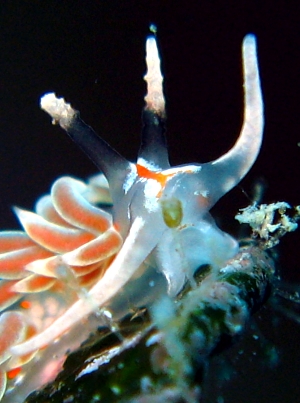
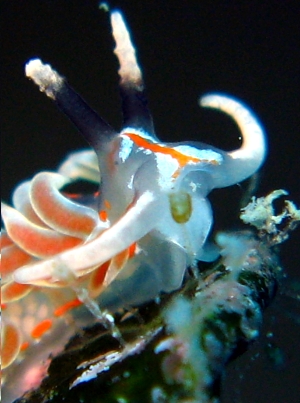
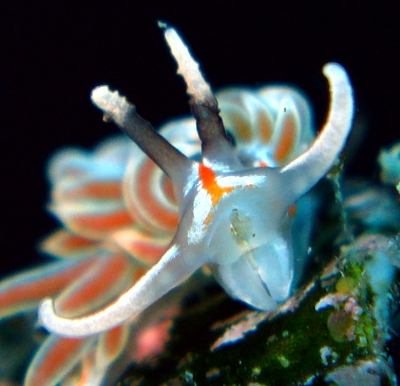
Dear Dom,
Thanks for these photos. What was particularly interesting is how the animal appears to use the elongate anterior foot corners to hold the stalk of the polyp while it is in the process of eating it. This reminded me of a discussion I had some time ago about an almost identical behaviour by Flabellina iodinea [see message #19389]. Perhaps it is a general behaviour amongst hydroid feeding aeolids with tentacular foot corners.
Best wishes,
Bill Rudman
Re: Facelina rubrovittata from southern France
February 11, 2008
From: Dominique Horst
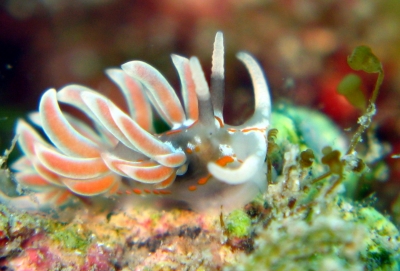
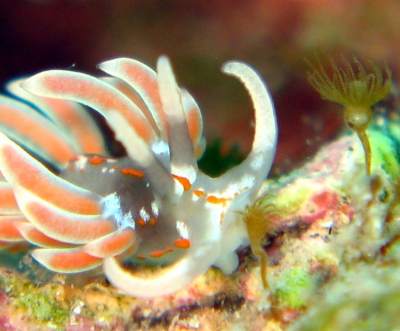
Concerning message #4514:
Hello Bill,
For the first time I found Facelina rubrovittata.
I was lucky because it started eating hydroids. I don't know which species of hydroids, (Eudendrium sp?) but the Facelina seemed to appreciate them.
Locality: Antibes Cape, 7 m, France, Mediterranean sea, 16 December 2007. Length: 7 mm. Photographer: Dominique Horst.
Kind regards,
Dom.
dominique.horst@wanadoo.fr
Horst, D., 2008 (Feb 11) Re: Facelina rubrovittata from southern France. [Message in] Sea Slug Forum. Australian Museum, Sydney. Available from http://www.seaslugforum.net/find/21318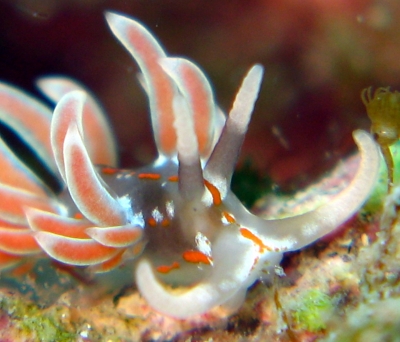
Dear Dom,
Thanks for this interesting record. Hopefully someone can help with identifying the hydroid. I am not an expert on hydroids but I thought most species of Eudendrium consisted of branching colonies. Your photo suggests this has unbranched stalks, but it may be an early stage in colony growth.
Best wishes,
Bill Rudman
Is this Facelina rubrovittata ?
August 29, 2006
From: Cristian Magnani

Dear Bill
I think this tiny aeolid nudibranch might be a specimen of Facelina rubrovitta and I'd like to know your opinion about it. The nudi was moving pretty fast so probably the sponge on the bottom is not is food.
Locality: Secca della Vedova, Capraia, Tremiti Islands, 15 metres, Italy, Adriatic Sea, 18 August 2006, on rock wall. Length: 6 mmw. Photographer: Cristian Magnani.
Thanks a lot
Best regards
Cristian
http://www.nudibranchi.it/Eng_main.htm
info@nudibranchi.it
Magnani, C., 2006 (Aug 29) Is this Facelina rubrovittata ?. [Message in] Sea Slug Forum. Australian Museum, Sydney. Available from http://www.seaslugforum.net/find/17536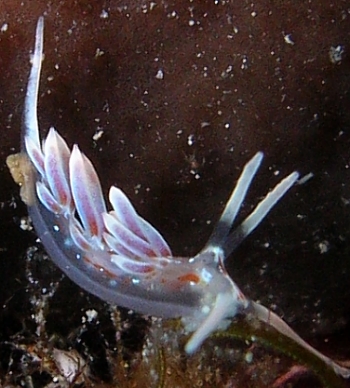
Dear Cristian,
I am pretty sure this is a juvenile Facelina rubrovitta. The white-tipped rhinophores, oral tentacles, and cerata, are all ways of separating it from the similarly coloured Facelina fusca. In adults there are rounded ridges on the rhinophores, but in adults they ahve not developed. In your animal there a few small bumps visible on the lower photo which could be the beginnings of these ridges. These aeolids are hydroid feeders.
Best wishes,
Bill Rudman
Facelina rubrovittata? from Turkey
November 23, 2001
From: Baki Yokes
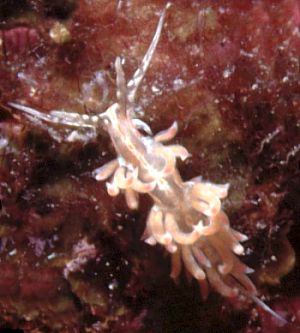
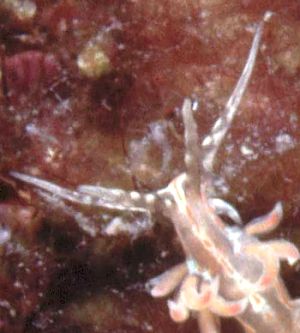
Dear Bill,
Here is an other interesting photo from Antalya, Turkey. It looks like Facelina rubrovittata. If so, I think this is also a new record for the Eastern Mediterranean malacofauna.
Place: Antalya, Turkey
Dive site: Uc Adalar
Depth: 4m
Size: 1cm
Date: June 2001
Photo: Adnan Buyuk: ado2000tr@yahoo.com
Best wishes
Baki
bakiyokes@turk.net
Yokes, B., 2001 (Nov 23) Facelina rubrovittata? from Turkey. [Message in] Sea Slug Forum. Australian Museum, Sydney. Available from http://www.seaslugforum.net/find/5677Dear Baki,
It certainly looks like Facelina rubrovittata. As you say, this is another interesting expansion to the known geographic range of the species.
best wishes,
Bill Rudman
Re: Aeolid from Italy
July 19, 2001
From: Juan Lucas Cervera
Hi Bill,
This animal is a young Facelina rubrovittata.
Cheers.
Lucas.
lucas.cervera@uca.es
Cervera, J.L., 2001 (Jul 19) Re: Aeolid from Italy. [Message in] Sea Slug Forum. Australian Museum, Sydney. Available from http://www.seaslugforum.net/find/4849Thanks Lucas,
It's always good to be able to remove something from the unidentified page.
Bill Rudman
Facelina rubrovittata from southern France
June 7, 2001
From: Jean-Pierre Bielecki

Hello Bill
Here is another species which needs identification. Thanks again for your help.
Date: 27 may 2001
Place: France - Cap d'Antibes
Dive site: Le Grand Boule
Depth: 6m
Size: 7mm
Best regards
Jean-Pierre Bielecki
bielecki.jeanpierre@free.fr
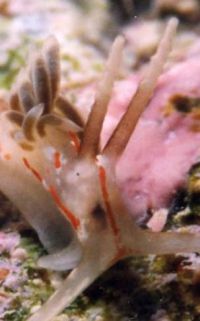
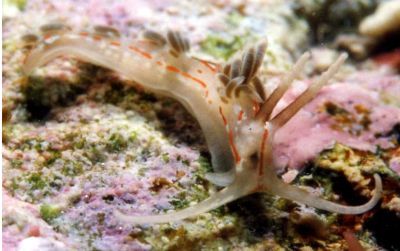
Dear Jean-Pierre,
I am pretty sure this is Facelina rubrovittata. I have included an enlargement of the head to show the wrinkles on the rhinophores.
Best wishes,
Bill Rudman
Facelina rubrovittata from Southern Spain
January 25, 2001
From: Alma Sánchez

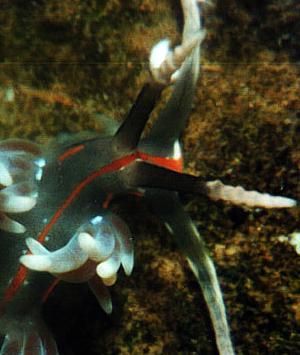
Dear Dr. Rudman,
Here is a photo of Facelina rubrovittata ( Costa, A., 1866) with the typical colour pattern.
Data: Bay of Algeciras (Strait of Gibraltar, Southern Spain), Size: 20 mm, Depth: 18 m., Date: April 2000.
Best Wishes,
Alma Sánchez
Dear Alma,
Thanks for the photo. I have included a large view of the head to show the swellings on the rhinophores, which are, according to Schmekel & Portmann (1982), only found in adults.
By the way, have you an email address I can add to your messages?
Best wishes,
Bill Rudman
Aeolid from Italy
September 27, 2000
From: Erwin Koehler
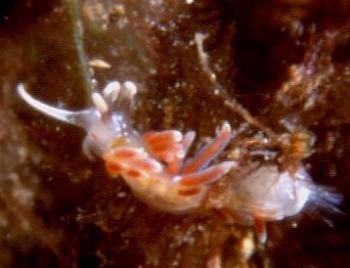
Dear Bill,
This one is from Finale Ligure, Italy, divesite "Bergeggi", depth 13 m, size ~ 5 mm, date July 22, 2000.
It was taken by Franco De Lorenzi
Email: cratena@libero.it
My first idea was Facelina coronata but I would like to hear the opinion of an expert.
Erwin
Medslugs.Koehler@t-online.de
Koehler, E., 2000 (Sep 27) Aeolid from Italy. [Message in] Sea Slug Forum. Australian Museum, Sydney. Available from http://www.seaslugforum.net/find/3078Dear Erwin,
I am not an expert on the Mediterranean fauna but I am sure we will get some comments from some.
It doesn't look like Facelina coronata to me. I would have thought the ridges or 'brackets' on the rhinophores would be visible in the photo if it were that species. It does look very like Calmella cavolini (Verany, 1846). I can't see whether the cerata in each group havea a common base, but the colour, including the white specks on the back and the tinge of purple jaw plates, are characteristic of Calmella cavolini.
But let's wait for an expert opinion.
Best wishes,
Bill Rudman.
Facelina rubrovittata from Spain
January 24, 2000
From: Miquel Pontes

We would like to know the etymology (origin of the name) of Facelina rubrovittata. We found this nudibranch in June 1998 in Cala Llevadó (Costa Brava, Spain) on a rocky bottom at 10 meters below the surface.
Miquel Pontes
mpontes@marenostrum.org
Pontes, M., 2000 (Jan 24) Facelina rubrovittata from Spain. [Message in] Sea Slug Forum. Australian Museum, Sydney. Available from http://www.seaslugforum.net/find/1774Dear Miquel,
It's helpful when authors give the origins of their names but in earlier times they seldom did. Some are based on simple Ancient Greek and Latin adjectives and are fairly easy to work out, others more difficult.
"rubro" = red and "vittata" = streaked, refers to the 5 rows of broken red lines this species usually has.
Other common adjectives often found in names are:
maculata = with irregular spots, blotches
punctata = spotted
lineata = with lines
Best wishes,
Bill Rudman.
